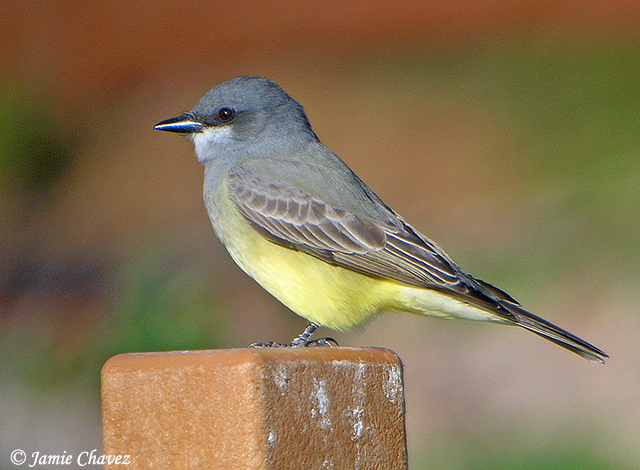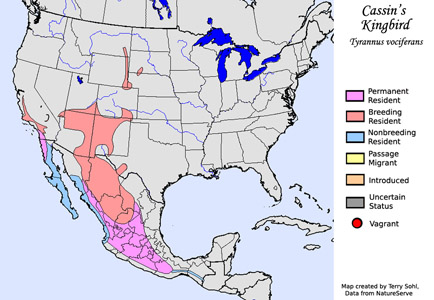Cassin's Kingbird
Tyrannus vociferans
| Length: 8 to 9 inches | Wingspan: 16 inches | Seasonality: Summer |
| ID Keys: Dull yellow underparts, gray back and breast, darker gray head, white chin. | ||
 Cassin's Kingbird is very similar to the Western
Kingbird and overlaps in range with it, but is found in more wooded habitats
than it's close cousin. Their scientific name "vociferans" comes from
their noisy, repetitive morning song.
Cassin's Kingbird is very similar to the Western
Kingbird and overlaps in range with it, but is found in more wooded habitats
than it's close cousin. Their scientific name "vociferans" comes from
their noisy, repetitive morning song.
Habitat: During the summer breeding season, they are found in semi-open woodlands, including pine forests, oak woodlands, riparian areas, and sometimes in isolated groves. They are generally found in more open habitats during migration and in winter.
Diet: Primarily feeds on berries. Will also feed on fruits and berries, more so than most of the flycatchers.
Behavior: Forages by flying out from a perch to capture flying insects. They will also hover and glean insects from foliage and branches.
Nesting: Mid-May through mid-July
Song: Song is an exuberant kideer-kideer-kideer.
Migration: Summers in portions of the interior West. Winters in Mexico and southward.
Interactive eBird Map: Click for access to an interactive eBird map of Cassin's Kingbird sightings
Similar Species: Western Kingbird, Tropical Kingbird
Conservation Status: Numbers appear to be stable.
Further Information: 1) USGS Patuxent Bird Identification InfoCenter, Cassin's Kingbird
2) Cornell University's "All About Birds - Cassin's Kingbird"
3) Audubon Guide - Cassin's Kingbird
Photo Information: Photo courtesy of Jamie Chavez.
| Click on the map below for a higher-resolution view |
 |
| South Dakota Status: Casual summer resident in the southwestern part of the state. |
Additional Cassin's Kingbird Photos (coming soon!)
